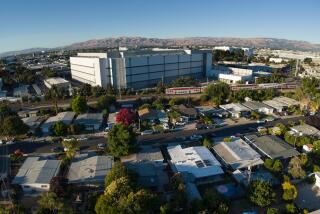Power Plant’s Fate Depends on Efficiency : SDG&E; Geothermal Operation Is Unique
- Share via
Technically, San Diego Gas & Electric Co.’s geothermal-powered electricity-generating plant at Heber appears to be a winner.
For nearly two years, the demonstration plant in Imperial Valley has been extracting underground geothermal brines and using them to power a turbine that drives a generator that produces electricity.
But unless oil prices and the demand for electricity increase, the unique plant will not be a cost-effective commercial power plant, according to utility industry experts.
But when SDG&E; eventually asks the state Public Utility Commission to certify the Heber plant as a commercial power plant, the utility will have to prove that it is a cost-effective alternative to more traditional--and, currently, less expensive--power plants.
Should regulators determine that Heber’s electricity is too expensive, SDG&E; might have to mothball the plant or sell its controlling interest.
If the plant were to “go commercial today with oil at what it’s at right now (about $19 a barrel), I don’t think (the plant) could compete,” acknowledged Robert Lacy, manager of SDG&E;’s Heber Binary Project. “Geothermal is a more viable option than some of the more esoteric technologies, but for the project to succeed, we need the price of oil to reach a little over $20 per barrel.”
The Heber project made economic sense in 1982 when the state Public Utilities Commission approved the demonstration plant. Then, successive oil shortages had driven the price of fuel oil and natural gas sky-high.
But today’s relatively cheap oil and gas have made geothermal power--and alternative technologies such as wind, solar, coal gasification and oil shale--uneconomical.
SDG&E; and the Electric Power Research Institute, a Palo Alto-based research organization, believe oil prices eventually will rise, making the plant a cost-effective source of electricity.
“Prices are nudging against that range right now,” according to Basel Roberts, the institute’s program manager for geothermal power systems.
Economics aside, the technical aspects of the project that is expected to generate enough electric power to meet the needs of 45,000 people have been a success. Unlike other geothermal plants that use extremely hot brines, the “binary” plant at Heber is powered by lower-temperature geothermal deposits that are stored deep beneath the Imperial Valley’s floor.
The plant extracts those lower-temperature brines--about 300 to 500 degrees Fahrenheit--and uses them to heat a second fluid. When heated, that fluid turns to steam, which drives the plant’s turbines. Spent brine subsequently is re-injected into the earth.
“We’re very pleased with the results of the work so far,” Roberts said, adding, however, that there is a “cloud on the horizon.” Researchers had hoped to collect two years of data with the plant operating at full capacity. However, a predicted budget shortfall has forced researchers to settle for a one-year demonstration.
So far, the demonstration plant has generated as much as 26 megawatts of electricity. After a second set of geothermal wells is drilled, the plant is expected to reach its 45-megawatt design capacity.
According to SDG&E;’s initial plan, the plant was to begin operating at full capacity some time this year. However, Unocal and Chevron corporations, which are drilling the geothermal wells, are behind schedule.
So far, SDG&E; has spent more than $60 million in customer funds to build the plant. The PUC in 1982 agreed to let SDG&E; spend as much as $94 million from customers to build and operate the $188.5-million demonstration plant.
The federal Department of Energy, the state of California, the Imperial Valley Irrigation District, Southern California Edison and seven other private and public organizations have provided the rest of the funding.
However, electricity generated by the plant is shared only by its owners, which include SDG&E;, the irrigation district and the state.
The technology being tested at Heber is important to SDG&E; because the utility sits in what Thomas Page, chairman and chief executive, has described as an “energy desert.”
The utility hopes to use the binary system to exploit the geothermal brine that sits far below the surface of Southern California.
Geothermal plants might one day produce as much as 20% of SDG&E;’s electricity, said Lacy, who added that geothermal energy could meet 5% of the global demand for electricity.
Though the technology being used at Heber is complex, the idea is an old one.
SDG&E; is tapping the same geothermal energy that the Romans and Greeks harnessed to warm their gymnasiums and that for generations has heated homes and businesses in Iceland.
In Northern California, utilities are using underground steam to spin electricity-generating turbines. And, just a few hundred yards from the Heber plant, Dravo Corp. is developing a plant that uses conventional geothermal technology.
That plant uses a “flash” process that needs extremely hot geothermal reservoirs that, when pumped to the earth’s surface, flash into steam, powering a turbine that drives a generator. However, half of the world’s known geothermal deposits are not hot enough for the flash process.
More to Read
Inside the business of entertainment
The Wide Shot brings you news, analysis and insights on everything from streaming wars to production — and what it all means for the future.
You may occasionally receive promotional content from the Los Angeles Times.









